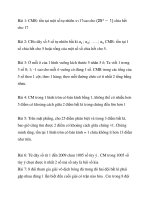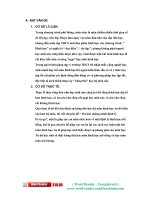- Trang chủ >>
- Y - Dược >>
- Truyền nhiễm
Cach chung minh dinh li Pythagore bang Tieng Anh
Bạn đang xem bản rút gọn của tài liệu. Xem và tải ngay bản đầy đủ của tài liệu tại đây (205.78 KB, 8 trang )
<span class='text_page_counter'>(1)</span><div class='page_container' data-page=1>
<b>How to prove Pythagore theorem</b>
<b>Proofs</b>
This is a theorem that may have more known proofs than any other; the book <i>Pythagorean </i>
<i>Proposition</i>, by Elisha Scott Loomis, contains 367 proofs.
<b>[</b>
<b>edit</b>
<b>] Proof using similar triangles</b>
Proof using similar triangles.
Like most of the proofs of the Pythagorean theorem, this one is based on the proportionality of
the sides of two similar triangles.
Let <i>ABC</i> represent a right triangle, with the right angle located at <i>C</i>, as shown on the figure. We
draw the altitude from point <i>C</i>, and call <i>H</i> its intersection with the side <i>AB</i>. The new triangle
<i>ACH</i> is similar to our triangle <i>ABC</i>, because they both have a right angle (by definition of the
altitude), and they share the angle at <i>A</i>, meaning that the third angle will be the same in both
triangles as well. By a similar reasoning, the triangle CBH is also similar to <i>ABC</i>. The
similarities lead to the two ratios..: As
so
These can be written as
Summing these two equalities, we obtain
</div>
<span class='text_page_counter'>(2)</span><div class='page_container' data-page=2>
<b>[</b>
<b>edit</b>
<b>] Euclid's proof</b>
Proof in Euclid's <i>Elements</i>
In Euclid's <i>Elements</i>, Proposition 47 of Book 1, the Pythagorean theorem is proved by an
argument along the following lines. Let <i>A</i>, <i>B</i>, <i>C</i> be the vertices of a right triangle, with a right
angle at <i>A</i>. Drop a perpendicular from <i>A</i> to the side opposite the hypotenuse in the square on the
hypotenuse. That line divides the square on the hypotenuse into two rectangles, each having the
same area as one of the two squares on the legs.
For the formal proof, we require four elementary lemmata:
1. If two triangles have two sides of the one equal to two sides of the other, each to each,
and the angles included by those sides equal, then the triangles are congruent. (Side -
Angle - Side Theorem)
2. The area of a triangle is half the area of any parallelogram on the same base and having
the same altitude.
3. The area of any square is equal to the product of two of its sides.
4. The area of any rectangle is equal to the product of two adjacent sides (follows from
Lemma 3).
The intuitive idea behind this proof, which can make it easier to follow, is that the top squares
are morphed into parallelograms with the same size, then turned and morphed into the left and
right rectangles in the lower square, again at constant area.
The proof is as follows:
1. Let ACB be a right-angled triangle with right angle CAB.
2. On each of the sides BC, AB, and CA, squares are drawn, CBDE, BAGF, and ACIH, in
that order.
3. From A, draw a line parallel to BD and CE. It will perpendicularly intersect BC and DE
at K and L, respectively.
</div>
<span class='text_page_counter'>(3)</span><div class='page_container' data-page=3>
Illustration including the new lines
1. Angles CAB and BAG are both right angles; therefore C, A, and G are collinear.
Similarly for B, A, and H.
2. Angles CBD and FBA are both right angles; therefore angle ABD equals angle FBC,
since both are the sum of a right angle and angle ABC.
3. Since AB and BD are equal to FB and BC, respectively, triangle ABD must be equal to
triangle FBC.
4. Since A is collinear with K and L, rectangle BDLK must be twice in area to triangle
ABD.
5. Since C is collinear with A and G, square BAGF must be twice in area to triangle FBC.
6. Therefore rectangle BDLK must have the same area as square BAGF = AB2<sub>.</sub>
7. Similarly, it can be shown that rectangle CKLE must have the same area as square ACIH
= AC2<sub>.</sub>
8. Adding these two results, AB2<sub> + AC</sub>2<sub> = BD × BK + KL × KC</sub>
9. Since BD = KL, BD* BK + KL × KC = BD(BK + KC) = BD × BC
10. Therefore AB2<sub> + AC</sub>2<sub> = BC</sub>2<sub>, since CBDE is a square.</sub>
This proof appears in Euclid's <i>Elements</i> as that of Proposition 1.47.
<b>[</b>
<b>edit</b>
<b>] Garfield's proof</b>
</div>
<span class='text_page_counter'>(4)</span><div class='page_container' data-page=4>
Proof using area subtraction.
<b>[</b>
<b>edit</b>
<b>] Similarity proof</b>
From the same diagram as that in Euclid's proof above, we can see three similar figures, each
being "a square with a triangle on top". Since the large triangle is made of the two smaller
triangles, its area is the sum of areas of the two smaller ones. By similarity, the three squares are
in the same proportions relative to each other as the three triangles, and so likewise the area of
the larger square is the sum of the areas of the two smaller squares.
<b>[</b>
<b>edit</b>
<b>] Proof by rearrangement</b>
A proof by rearrangement is given by the illustration and the animation. In the illustration, the
area of each large square is (<i>a</i> + <i>b</i>)2<sub>. In both, the area of four identical triangles is removed. The </sub>
remaining areas, <i>a</i>2<sub> + </sub><i><sub>b</sub></i>2<sub> and </sub><i><sub>c</sub></i>2<sub>, are equal. Q.E.D.</sub>
Animation showing another proof by rearrangement.
</div>
<span class='text_page_counter'>(5)</span><div class='page_container' data-page=5>
A square created by aligning four right angle triangles and a large square.
This proof is indeed very simple, but it is not <i>elementary</i>, in the sense that it does not depend
solely upon the most basic axioms and theorems of Euclidean geometry. In particular, while it is
quite easy to give a formula for area of triangles and squares, it is not as easy to prove that the
area of a square is the sum of areas of its pieces. In fact, proving the necessary properties is
harder than proving the Pythagorean theorem itself and Banach-Tarski paradox. Actually, this
difficulty affects all simple Euclidean proofs involving area; for instance, deriving the area of a
right triangle involves the assumption that it is half the area of a rectangle with the same height
and base. For this reason, axiomatic introductions to geometry usually employ another proof
based on the similarity of triangles (see above).
A third graphic illustration of the Pythagorean theorem (in yellow and blue to the right) fits parts
of the sides' squares into the hypotenuse's square. A related proof would show that the
repositioned parts are identical with the originals and, since the sum of equals are equal, that the
corresponding areas are equal. To show that a square is the result one must show that the length
of the new sides equals <i>c</i>. Note that for this proof to work, one must provide a way to handle
cutting the small square in more and more slices as the corresponding side gets smaller and
smaller.[1]
<b>[</b>
<b>edit</b>
<b>] Algebraic proof</b>
An algebraic variant of this proof is provided by the following reasoning. Looking at the
illustration which is a large square with identical right triangles in its corners, the area of each of
these four triangles is given by an angle corresponding with the side of length <i>C</i>.
</div>
<span class='text_page_counter'>(6)</span><div class='page_container' data-page=6>
However, as the large square has sides of length <i>A</i> + <i>B</i>, we can also calculate its area as (<i>A</i> + <i>B</i>)2<sub>, </sub>
which expands to <i>A</i>2<sub> + </sub><i><sub>2AB</sub></i><sub> + </sub><i><sub>B</sub></i>2<sub>.</sub>
(Distribution of the 4)
(Subtraction of 2<i>AB</i>)
<b>[</b>
<b>edit</b>
<b>] Proof by differential equations</b>
One can arrive at the Pythagorean theorem by studying how changes in a side produce a change
in the hypotenuse in the following diagram and employing a little calculus.
Proof using differential equations.
As a result of a change in side <i>a</i>,
by similar triangles and for differential changes. So
upon separation of variables.
which results from adding a second term for changes in side <i>b</i>.
Integrating gives
</div>
<span class='text_page_counter'>(7)</span><div class='page_container' data-page=7>
As can be seen, the squares are due to the particular proportion between the changes and the
sides while the sum is a result of the independent contributions of the changes in the sides which
is not evident from the geometric proofs. From the proportion given it can be shown that the
changes in the sides are inversely proportional to the sides. The differential equation suggests
that the theorem is due to relative changes and its derivation is nearly equivalent to computing a
line integral.
These quantities <i>da</i> and <i>dc</i> are respectively infinitely small changes in <i>a</i> and <i>c</i>. But we use
instead real numbers Δ<i>a</i> and Δ<i>c</i>, then the limit of their ratio as their sizes approach zero is <i>da</i>/<i>dc</i>,
the derivative, and also approaches <i>c</i>/<i>a</i>, the ratio of lengths of sides of triangles, and the
differential equation results.
<b>[</b>
<b>edit</b>
<b>] Converse</b>
The converse of the theorem is also true:
For any three positive numbers <i>a</i>, <i>b</i>, and <i>c</i> such that <i>a</i>2<sub> + </sub><i><sub>b</sub></i>2<sub> = </sub><i><sub>c</sub></i>2<sub>, there exists a triangle with sides </sub>
<i>a</i>, <i>b</i> and <i>c</i>, and every such triangle has a right angle between the sides of lengths <i>a</i> and <i>b</i>.
This converse also appears in Euclid's <i>Elements</i>. It can be proven using the law of cosines, or by
the following proof:
Let <i>ABC</i> be a triangle with side lengths <i>a</i>, <i>b</i>, and <i>c</i>, with <i>a</i>2<sub> + </sub><i><sub>b</sub></i>2<sub> = </sub><i><sub>c</sub></i>2<sub>. We need to prove that the </sub>
angle between the <i>a</i> and <i>b</i> sides is a right angle. We construct another triangle with a right angle
between sides of lengths <i>a</i> and <i>b</i>. By the Pythagorean theorem, it follows that the hypotenuse of
this triangle also has length <i>c</i>. Since both triangles have the same side lengths <i>a</i>, <i>b</i> and <i>c</i>, they are
congruent, and so they must have the same angles. Therefore, the angle between the side of
lengths <i>a</i> and <i>b</i> in our original triangle is a right angle.
A corollary of the Pythagorean theorem's converse is a simple means of determining whether a
triangle is right, obtuse, or acute, as follows. Where <i>c</i> is chosen to be the longest of the three
sides:
If <i>a</i>2 + <i>b</i>2 = <i>c</i>2, then the triangle is right.
If <i>a</i>2 + <i>b</i>2 > <i>c</i>2, then the triangle is acute.
If <i>a</i>2 + <i>b</i>2 < <i>c</i>2, then the triangle is obtuse.
<b>[</b>
<b>edit</b>
<b>] Consequences and uses of the theorem</b>
<b>[</b>
<b>edit</b>
<b>] Pythagorean triples</b>
A Pythagorean triple has 3 positive numbers <i>a</i>, <i>b</i>, and <i>c</i>, such that <i>a</i>2<sub> + </sub><i><sub>b</sub></i>2<sub> = </sub><i><sub>c</sub></i>2<sub>. In other words, a </sub>
</div>
<span class='text_page_counter'>(8)</span><div class='page_container' data-page=8>
triples were known before the discovery of writing. Such a triple is commonly written (<i>a</i>, <i>b</i>, <i>c</i>).
Some well-known examples are (3, 4, 5) and (5, 12, 13).
<b>[</b>
<b>edit</b>
<b>] List of primitive Pythagorean triples up to 100</b>
(3, 4, 5), (5, 12, 13), (7, 24, 25), (8, 15, 17), (9, 40, 41), (11, 60, 61), (12, 35, 37), (13, 84, 85),
(16, 63, 65), (20, 21, 29), (28, 45, 53), (33, 56, 65), (36, 77, 85), (39, 80, 89), (48, 55, 73), (65,
72, 97)
<b>[</b>
<b>edit</b>
<b>] The existence of irrational numbers</b>
One of the consequences of the Pythagorean theorem is that irrational numbers, such as the
square root of 2, can be constructed. A right triangle with legs both equal to one unit has
hypotenuse length square root of 2. The Pythagoreans proved that the square root of 2 is
irrational, and this proof has come down to us even though it flew in the face of their cherished
belief that everything was rational. According to the legend, Hippasus, who first proved the
irrationality of the square root of two, was drowned at sea as a consequence.
<b>[</b>
<b>edit</b>
<b>] Distance in Cartesian coordinates</b>
The distance formula in Cartesian coordinates is derived from the Pythagorean theorem. If (<i>x</i>0,
<i>y</i>0) and (<i>x</i>1, <i>y</i>1) are points in the plane, then the distance between them, also called the Euclidean
distance, is given by
</div>
<!--links-->
<a href=' /> Cách vào đề khi thuyết trình bằng tiếng Anh
- 1
- 2
- 18








